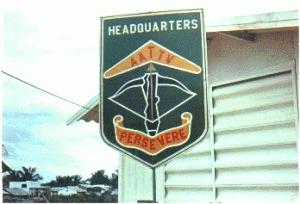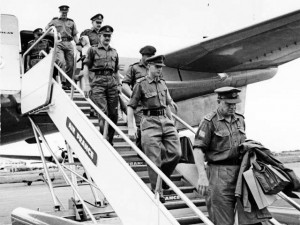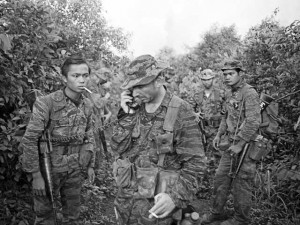Raising the Team
 This month we come forward in time and take a look at an Australian unit that became both the longest-serving and most highly decorated of the war in Vietnam. The Australian Army Training Team Vietnam (AATTV) was the first Australian unit deployed to Vietnam and the last to be withdrawn, being operational for over ten years.
By 1962 American support to South Vietnam had increased dramatically. As well as huge quantities of material support, there were 11,000 men deployed in a variety of military and civilian advisory roles. Concerned that the war was being seen increasingly as one of American imperialism against a national movement for independence, the US Government was anxious to internationalise the appearance of the conflict. In May 1962 Australia was approached to contribute to this early form of coalition warfare and, as it both suited our existing strategy of forward defence in South East Asia and could strengthen the Australian – US relationship, the request was approved.
Australian operational experience at that time was based on the deployment of units in support of the Malayan Emergency. Skills learned in the field and training in Australia were geared to counter-insurgency operations in a jungle setting, so it was decided that Australia’s most effective contribution in Vietnam would be in passing on these techniques. On 24 May the Australian Government announced that thirty instructors would deploy to Vietnam, their role being to train South Vietnamese forces in jungle warfare, including specialist functions such as engineering and signals support. The unit was to be commanded by Colonel F.P. (Ted) Serong, an officer who had previously been
This month we come forward in time and take a look at an Australian unit that became both the longest-serving and most highly decorated of the war in Vietnam. The Australian Army Training Team Vietnam (AATTV) was the first Australian unit deployed to Vietnam and the last to be withdrawn, being operational for over ten years.
By 1962 American support to South Vietnam had increased dramatically. As well as huge quantities of material support, there were 11,000 men deployed in a variety of military and civilian advisory roles. Concerned that the war was being seen increasingly as one of American imperialism against a national movement for independence, the US Government was anxious to internationalise the appearance of the conflict. In May 1962 Australia was approached to contribute to this early form of coalition warfare and, as it both suited our existing strategy of forward defence in South East Asia and could strengthen the Australian – US relationship, the request was approved.
Australian operational experience at that time was based on the deployment of units in support of the Malayan Emergency. Skills learned in the field and training in Australia were geared to counter-insurgency operations in a jungle setting, so it was decided that Australia’s most effective contribution in Vietnam would be in passing on these techniques. On 24 May the Australian Government announced that thirty instructors would deploy to Vietnam, their role being to train South Vietnamese forces in jungle warfare, including specialist functions such as engineering and signals support. The unit was to be commanded by Colonel F.P. (Ted) Serong, an officer who had previously been  commandant of the Jungle Training Centre in Queensland. The initial plan saw the men deployed in small detachments at training locations, three in the northern-most provinces of South Vietnam and one in the central coastal area, with a small headquarters in Saigon. This dispersed deployment offered both a more varied range of experience and a wider understanding of the nature of the conflict than could be gained from a centralised group location
The Team, as it was commonly known, was unique for a number of reasons. It had no parent formation or depot and did not exist as a unit outside of Vietnam. Personnel reliefs were on an individual or small draft basis, not by unit rotation. Unlike the 1st Australian Task Force (1 ATF) which came later, the Team operated over much of South
commandant of the Jungle Training Centre in Queensland. The initial plan saw the men deployed in small detachments at training locations, three in the northern-most provinces of South Vietnam and one in the central coastal area, with a small headquarters in Saigon. This dispersed deployment offered both a more varied range of experience and a wider understanding of the nature of the conflict than could be gained from a centralised group location
The Team, as it was commonly known, was unique for a number of reasons. It had no parent formation or depot and did not exist as a unit outside of Vietnam. Personnel reliefs were on an individual or small draft basis, not by unit rotation. Unlike the 1st Australian Task Force (1 ATF) which came later, the Team operated over much of South  Vietnam in a variety of training, advisory and command roles. Members of the Team were specially selected officers, warrant officers and NCOs, required to operate alone or in very small detachments. This type of employment, and the geographic dispersion involved, meant that AATTV was almost never together as a unit. Working within the US advisory structure, Team members were involved with the South Vietnamese Army (ARVN), Special Forces and CIA personnel, South Vietnamese irregular forces, Montagnard tribesmen and mercenary elements, giving them a special perspective of the war.
A US request for additional manpower and a role change in 1964 resulted in a new phase for the Team. Strength was increased to 83 and members were employed at battalion and company level in the field for the first time, advising on tactics and assisting with artillery and air support to operations. There was also a redeployment of some personnel into US Special Forces (USSF) teams as some training locations closed. This increased involvement in operations resulted in the Team’s first combat death when Warrant Officer Class 2 Kevin Conway was killed during a Viet Cong attack on the Nam Dong Special Forces camp on 6 July 1964 (Sergeant W.F. Hacking had been killed accidentally on 1 June 1963).
Between 1965 and 1971 the Team was increasingly involved with ARVN units, USSF teams, territorial forces and para-military activities throughout South Vietnam. During this period all but two of the Team’s 33 fatal casualties occurred and four Victoria Crosses were awarded. Strength was further increased to 112 in 1965 and again, to 217, in 1970. For the first time a New Zealand component was added to the Team, with five members arriving in October of that year.
1971 saw the beginning of the drawdown of Australian forces in Vietnam, with 1000 men withdrawn from 1 ATF and 22 from AATTV. By the end of the year the Team was concentrated in Phuoc Tuy province, in a training and advisory capacity, where it remained until the final Australian withdrawal in December 1972.
AATTV was unique in Australian military experience. With an average strength, throughout its operational life, of 100 the Team suffered 32 killed and 122 wounded in action. Its members were awarded a total of 113 decorations, including four VCs. So small, when compared to the contingents of other participating countries, the Team punched far above its weight, more than exceeding original expectations.
Article written by Rod Margetts - who is a battlefield tour guide for Boronia Travel Centre.
Image Top Left: Team logo outside of HQ AATTV 1972. Photo courtesy of David Winch HQ AAAGV 1972. Source: www.aattv.iinet.net.au/hqaattv.html
Image Right: Members of the Australian Army Training Team Vietnam’s (AATTV) first contingent disembark from the aircraft that has brought them to Saigon on 3 August 1962. These men were at the vanguard of Australia’s decade-long involvement in the war and were among the first of some one thousand soldiers to serve in the AATTV. [AWM P01011.004]
Image Bottom Left: A member of the Australian Army Training Team Vietnam, Captain Peter Shilston, confirming by radio that the village that he is about to search with South Vietnamese troops has been properly cordoned. Shilston was one of six AATTV members to be awarded the Military Cross during his service in South Vietnam. [AWM FAI/70/0595/VN]
Vietnam in a variety of training, advisory and command roles. Members of the Team were specially selected officers, warrant officers and NCOs, required to operate alone or in very small detachments. This type of employment, and the geographic dispersion involved, meant that AATTV was almost never together as a unit. Working within the US advisory structure, Team members were involved with the South Vietnamese Army (ARVN), Special Forces and CIA personnel, South Vietnamese irregular forces, Montagnard tribesmen and mercenary elements, giving them a special perspective of the war.
A US request for additional manpower and a role change in 1964 resulted in a new phase for the Team. Strength was increased to 83 and members were employed at battalion and company level in the field for the first time, advising on tactics and assisting with artillery and air support to operations. There was also a redeployment of some personnel into US Special Forces (USSF) teams as some training locations closed. This increased involvement in operations resulted in the Team’s first combat death when Warrant Officer Class 2 Kevin Conway was killed during a Viet Cong attack on the Nam Dong Special Forces camp on 6 July 1964 (Sergeant W.F. Hacking had been killed accidentally on 1 June 1963).
Between 1965 and 1971 the Team was increasingly involved with ARVN units, USSF teams, territorial forces and para-military activities throughout South Vietnam. During this period all but two of the Team’s 33 fatal casualties occurred and four Victoria Crosses were awarded. Strength was further increased to 112 in 1965 and again, to 217, in 1970. For the first time a New Zealand component was added to the Team, with five members arriving in October of that year.
1971 saw the beginning of the drawdown of Australian forces in Vietnam, with 1000 men withdrawn from 1 ATF and 22 from AATTV. By the end of the year the Team was concentrated in Phuoc Tuy province, in a training and advisory capacity, where it remained until the final Australian withdrawal in December 1972.
AATTV was unique in Australian military experience. With an average strength, throughout its operational life, of 100 the Team suffered 32 killed and 122 wounded in action. Its members were awarded a total of 113 decorations, including four VCs. So small, when compared to the contingents of other participating countries, the Team punched far above its weight, more than exceeding original expectations.
Article written by Rod Margetts - who is a battlefield tour guide for Boronia Travel Centre.
Image Top Left: Team logo outside of HQ AATTV 1972. Photo courtesy of David Winch HQ AAAGV 1972. Source: www.aattv.iinet.net.au/hqaattv.html
Image Right: Members of the Australian Army Training Team Vietnam’s (AATTV) first contingent disembark from the aircraft that has brought them to Saigon on 3 August 1962. These men were at the vanguard of Australia’s decade-long involvement in the war and were among the first of some one thousand soldiers to serve in the AATTV. [AWM P01011.004]
Image Bottom Left: A member of the Australian Army Training Team Vietnam, Captain Peter Shilston, confirming by radio that the village that he is about to search with South Vietnamese troops has been properly cordoned. Shilston was one of six AATTV members to be awarded the Military Cross during his service in South Vietnam. [AWM FAI/70/0595/VN]
This entry was posted in Historical Highlights. Bookmark the permalink.







Good article, don’t forget the 10 Kiwis who served in the AATTV